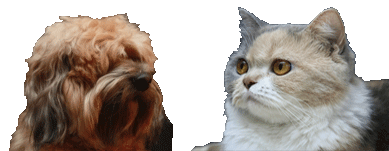Information about the Pyrenean Mountain Dog
The Pyrenean Mountain Dog, known as the Great Pyrenees in North America, is a large breed of dog used as a livestock guardian dog. It should not be confused with the Pyrenean Mastiff.
The Great Pyrenees is a very old breed that has been used for hundreds of years by shepherds, including those of the Basque people, who inhabit parts of the region in and around the Pyrenees Mountains of southern France and northern Spain. One of the first descriptions of the breed dates from 1407, and from 1675 the breed was a favourite of The Grand Dauphin and other members of the French aristocracy. By the early nineteenth century there was a thriving market for the dogs in mountain towns, from where they would be taken to other parts of France. It was developed to guard sheep on steep mountainous slopes with agility.
As late as 1874 the breed was not completely standardised in appearance, with two major sub-types recorded, the Western and the Eastern. They are related to several other large white European livestock guardian dogs (LGD), including the Italian Maremma Sheepdog, Kuvasz (Hungary), Akbash Dog (Turkey) and Polish Tatra or Polski Owczarek Podhalan’ski, and somewhat less closely to the Newfoundland and St. Bernard. According to the Great Pyrenees Club of America, the Great Pyrenees is naturally nocturnal and aggressive with any predators that may harm its flock. However, the breed can typically be trusted with small, young, and helpless animals of any kind due to its natural guardian instinct.
The Great Pyrenees breed has experienced a dramatic fall off in the number of U.S. AKC breed registrations from 2000 to 2010. The breed was ranked at #45 in 2000 and by 2010 Great Pyrenees had dropped to #71. Other large breeds in the same working group classification, Newfoundland and St. Bernard, have fared far better in maintaining their breed rankings. In 2010 Newfoundland and St. Bernard were ranked #44 and #45 respectively. Newfoundland moved up in the rankings from #53 in 2000. St. Bernard declined from #36 in the 2000 rankings, although in 2009 and 2010 registrations have held fast at #45. In the one year period alone from 2009-2010, the Great Pyrenees experienced a drastic 7-point drop in registrations. Although AKC rankings are not a true gauge of a breed’s popularity, the change in the AKC rankings may reflect a realignment in the sources of the dogs available to the general public. A large number of dogs coming from shelters in the South and Midwest U.S., now available through rescue societies, and the introduction of other breed registry services both play a part in the continuing decline in Great Pyrenees’ AKC registrations.
Males grow to 110-120 pounds (50-54 kg) and 27-32 inches (69-81 cm), while females reach 80-90 pounds (36-41 kg) and 25-29 inches (63-74 cm). On average, their lifespan is 10 to 12 years. The height at the front shoulders ranges from 27 to 32 inches (69 to 81 cm) for dogs and from 25 to 29 inches (63 to 74 cm) for bitches. A 27 inches (69 cm) dog weighs about 100 pounds (45 kg) and a 25 inches (64 cm) bitch weighs about 85 pounds (39 kg). Weight is in proportion to the overall size and structure. Commensurate with size there is sufficient bone and muscle to provide a balance with the frame.
The weather resistant double coat consists of a long, flat, thick, outer coat of coarse hair, straight or slightly undulating, and lying over a dense, fine, woolly undercoat. The coat is more profuse about the neck and shoulders where it forms a ruff or mane, more pronounced in males, to fend off wolves that may attack their neck. Longer hair on the tail forms a plume. There is feathering along the back of the front legs and along the back of the thighs, giving a “pantaloon” effect. The hair on the face and ears is shorter and of finer texture.
The main coat color is white and can have varying shades of gray, red (rust), or tan around the face (including a full face mask), ears and sometimes on the body and tail. As Great Pyrenees mature, their coats grow thicker and the longer colored hair of the coat often fades on those dogs that were not born completely white. Sometimes a little light tan or lemon will appear later in life around the ears and face. Being a double-coated breed, the undercoat can also have color and the skin as well. The color of the nose and on the eye rims should be jet black. Grey or tan markings that remain lend the French name, “blaireau”, (badger) which is a similar grizzled mixture color seen in the European badger. More recently, any color is correctly termed “Badger” or “Blaireau”.
One singular characteristic of the Great Pyrenees is the unique double dew claws on each hind leg.
In nature, the Great Pyrenees is confident, gentle (especially with children), and affectionate. While territorial and protective of its flock or family when necessary, its general demeanor is one of composure and patience. It is a strong willed, independent and reserved breed. It is also attentive, quite fearless and loyal to its duties. The Great Pyrenees’ size makes it an imposing guardian. A dog of this breed will patrol its perimeter and may wander away if off lead in an unenclosed space. The Great Pyrenees also tends to growl and bark a lot unless trained against such behavior.
The Great Pyrenees can be slow to learn new commands, slow to obey, and somewhat stubborn to train. For this reason the breed is ranked # 64 (out of 69 breeds) in Stanley Coren’s The Intelligence of Dogs. Despite this relative stubbornness, it is quite unusual for the Great Pyrenees to become aggressive or turn on its master. They also need a lot of space in which to roam.
[Back]

